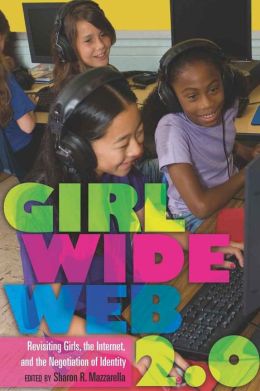 |
| Image from here |
Girl Wide Web 2.0 (check it out on Goodreads or Amazon) is
about how girls and women are renegotiating their identities through means of
the Internet. The book is written in a series of essays; each author has taken
a specific subject of the Internet which girls and women that are participating
in and has analyzed how their culture has redefined how they represent
themselves online. In the foreword, Dafna Lemish writes, “Through the variety
of possibilities of engaging others online, girls … explore new opportunities
to express their voices, and so the Internet is involved in self-growth. Some
practices involve the construction of very private and individual identities
and a creative process of expression. Others experiment with social
relationships and create communities of ‘sisterhood.’”
I liked this book
and appreciated the perspectives that it had on the evolution of identity
online. While there was a lot of valuable information in the book as a whole, there
were two particular chapters that I found useful as far as expressing online
identities from different cultures: “Degrees of Caution: Arab Girls Unveil on
Facebook” and “East Meets West: Is There a Difference Between Tai and American
Girls’ Use of the Internet and Negotiation of Identity?”
In “Degrees of
Caution” these Arab girls use Facebook to communicate and not necessarily to
express their identity. One of the points that was made was that these Arab girls
were worried that the information they put about themselves online would be
misunderstood and harm their representations in their communities. One way this
issue was dealt with was to put “minimal information” about themselves on
Facebook; however, some girls were just more creative with the information they
posted such as using code words, utilizing privacy settings, or using pictures
that didn’t show their faces but still showed their interests.
In “East Meets West”
the authors compare how Thai and American Girls use the Internet to express
their identities and what is considered socially acceptable for their cultures.
Before getting into the study, the authors explain, “Adolescents may often
struggle with self-presentation, because at their stage of life, they are still
trying to figure out their personalities and still learning how to communicate
themselves.” From the findings of this study, the motives for using the
Internet differed quite a bit as for as why they chose to express themselves in
particular ways; however, when it came to the content of what was being posted
(family, school, relationships, etc.), the results were very similar, with a
few notable exceptions. “Findings from this study revealed that the girls from
these two cultures were more similar than different, but did have distinct
characteristics of cultural values and norms.”
I recommend this
book to anyone who is interested in learning more about how girls and women
choose to represent themselves online, especially girls and women from different
cultures. These women come from many different places all over the world, but
they all wanted the same thing: a way to express themselves online that
represented their values, no matter how their values differed.

No comments:
Post a Comment